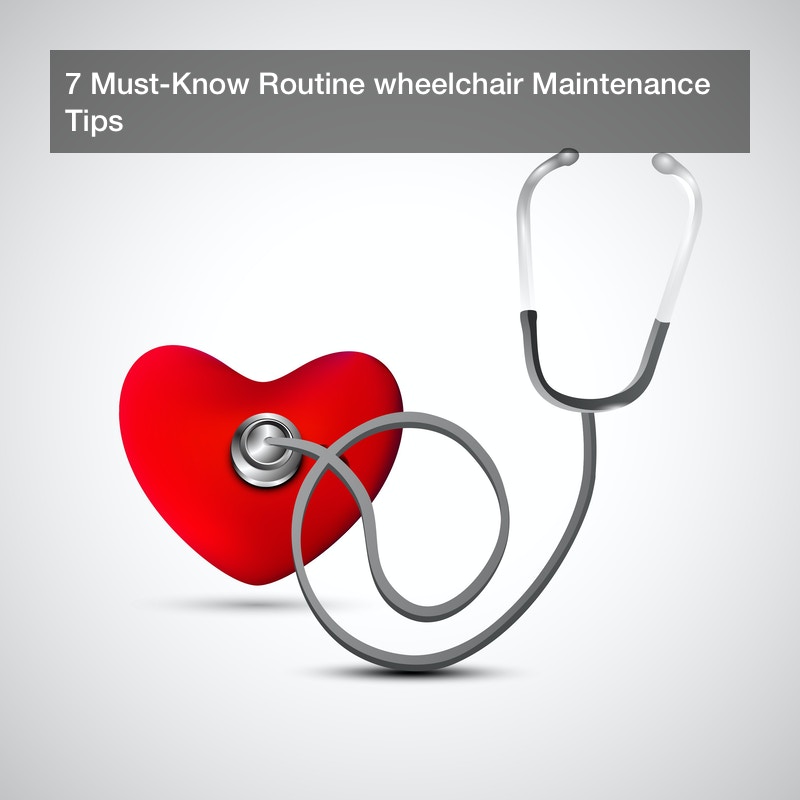
About 3.6 million people aged 15 years and above in the United States use wheelchair. Essentially, all wheelchairs require routine maintenance to operate well. Maintenance involves regular inspection, repairs, and replacements. Taking proper care of a wheelchair saves repair cost and extends life span. Also, a well-maintained wheelchair will be more comfortable, and easier to use. Wheelchair malfunction is one of the causes of wheelchair related injuries. In fact, poorly maintained wheelchairs increase risk of injury to users. Here are tips to guide all wheelchair users or caregivers to take care of a wheelchair.
1. Tires
If the tires for wheelchair are worn out, it will be difficult to propel the wheelchair. Ensure the tires are inspected regularly for cracks, flat spots, wear, loosens, and damage. Usually, you feel a flat spot when rolling on a smooth surface. If the tread is loose, cracked, or worn out contact the dealer or visit a bicycle shop instead of trying to fix it yourself. If the tire is completely worn out, consider replacing them.
2. Seat
Wheelchair seats should be very comfortable. Check for any sign of damaged seat rail. In addition, wheelchair requires regular cleaning with detergent and damp cloth. Unusually sound is a telltale sign of faulty seats. Cracks in wheelchair can be very dangerous. If you notice any cracks, you should contact your dealer right away. Wheelchair cushions affect the clinical safety, comfort, and performance of the user. When inspecting the seat, lookout for holes and tears. The good news is that there are myriads of seat cushions in the market.
3. Tubes
It is very easy to identify an issue with the tube. You can easily resolve a flat tire issue by replacing the tube. It is imperative to ensure you have ready to use tube just in case of tear.
4. Wheels
Wheels are a vital part of the wheelchair. Therefore, they should be given utmost care. Not many people appreciate the importance of caster or front wheel. Wheelchair casters provide direction. Any problem with casters will lead to mobility issues. Vibration emanating from the wheelchair wheels is enough reason to have them checked. Similarly, faulty casters will sway from side to side.
If your wheelchair wheels are very old and dirty, or have a rusty bearings, buying a new pair of caster wheel is a good idea. Another important part is the wheel bearing. Bearings for wheelchair allow the wheel to rotate freely on the wheel axis. Any damaged will increase rolling distance. Therefore, the user will spend more energy propelling. This stresses the shoulders. Here is the point, bearings are susceptible to wear over time. The first telltale sign of a faulty bearing is squeaky sound. As the condition gets worse, the sound will become more prominent.
It is also very important to ensure the spinergy wheelchair wheels are well aligned. If the wheel’s track is off, the wheelchair will drift during motion. The user will have to use one hand more often to travel in a straight line. As a result, the arm will be greatly strained. Also, it reduces wheelchair control and waste a lot of energy. Wheelchair wheels that are in good condition should not have excessive side motion when rolling or turning. The wheelchair should move in a straight line without excess pull, side motion, or drag.
5. Arms
Armrests provide comfort to the user. Wheelchair armpads should be designed to eliminate fatigue and improve the posture of the user. With time, armrests may get cracked and lose quality of becoming hard. If your armrests are no longer comfortable you should consider replacing them.
6. Nuts and Bolts
Checking if the nuts and bolts are in good shape is yet another important maintenance practice. Basically, you should ensure they are tight and well adjusted. Loose bolts and nuts will fail to hold the parts of the wheelchair firmly. You can visually identify loose bolts and nuts. Ensure the parts do not rattle when you move them. If you find loose bolts and nuts, tighten them until they snug.
7. Brakes
Wheelchair brakes come in handy when shifting from one surface to another. They also give the user more stability. Adjust the brakes if they are not working perfectly. If they still do not work properly contact an expert.


